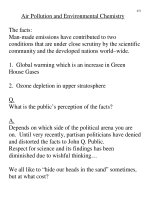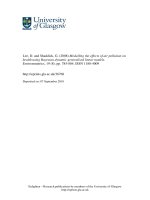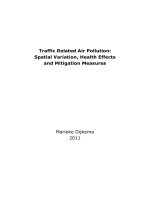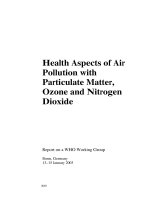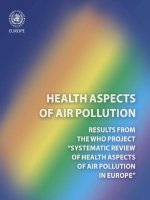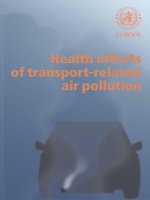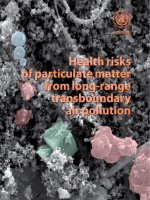LECTURE NOTES-For Environmental Health Science Students: Air Pollution ppt
Bạn đang xem bản rút gọn của tài liệu. Xem và tải ngay bản đầy đủ của tài liệu tại đây (842.22 KB, 217 trang )
LECTURE NOTES
For Environmental Health Science Students
Air Pollution
Mengesha Admassu,
Mamo Wubeshet
University of Gondar
In collaboration with the Ethiopia Public Health Training Initiative, The Carter Center,
the Ethiopia Ministry of Health, and the Ethiopia Ministry of Education
August 2006
Funded under USAID Cooperative Agreement No. 663-A-00-00-0358-00.
Produced in collaboration with the Ethiopia Public Health Training Initiative, The Carter
Center, the Ethiopia Ministry of Health, and the Ethiopia Ministry of Education.
Important Guidelines for Printing and Photocopying
Limited permission is granted free of charge to print or photocopy all pages of this
publication for educational, not-for-profit use by health care workers, students or
faculty. All copies must retain all author credits and copyright notices included in the
original document. Under no circumstances is it permissible to sell or distribute on a
commercial basis, or to claim authorship of, copies of material reproduced from this
publication.
©2005 by Mengesha Admassu, Mamo Wubeshet
All rights reserved. Except as expressly provided above, no part of this publication may
be reproduced or transmitted in any form or by any means, electronic or mechanical,
including photocopying, recording, or by any information storage and retrieval system,
without written permission of the author or authors.
This material is intended for educational use only by practicing health care workers or
students and faculty in a health care field.
i
PREFACE
Shortage of appropriate textbooks that could meet the need
for training professionals on the nature and the magnitude of
ambient and indoor air pollutions and their effects have been
one of the outstanding problems in the existing higher health
learning institutions in Ethiopia. Therefore, a well-developed
teaching material to produce the required qualified health
professionals, who are considered to shoulder the
responsibility of preventing and controlling of air pollutions by
creating awareness and entertaining some interventional
measures among the communities, is obvious.
The present lecture note on “Air pollution” is therefore,
prepared to be used as a teaching material to train mainly
environmental health and other students of health category in
Ethiopia. It is believed this teaching material plays a
significant role to solve the critical shortage of reference
books and text on the subject. The lecture note is designed to
make the training somehow a practical application to the
actual indoor and out door air pollutions in the country. It
contains five chapters in which the major current out/ in-door
air pollution problems with their suggested solutions are
discussed. Each chapter is presented in simple language and
is provided with learning objectives, body introduction,
exercises, and suggested reading as appropriate. Text books,
ii
journals, internet sources and other lecture manuscript are
used to develop this lecture material.
We have also incorporated the useful ideas of different
instructors of the course to standardize it to its present status,
which the authors hope to further improve the draft through
the consultations, pretest and revisions. It is also hoped that
this lecture note will be of particular use not only for students
of health category in colleges and universities, but to those
graduates working in health care service institutions and
environmental protection agencies.
iii
ACKNOWLEDGEMENTS
We would like to express our thanks to The Carter Center,
Atlanta Georgia, for financial supports to the subsequent
workshops conducted to develop the lecture note.
The Carter Center would also be acknowledged for providing
useful guidelines, technical and moral support during the
development of the lecture note. All the instructors, who
teach the courses in the existing higher teaching-learning
institutions, who critically reviewed the manuscript on
subsequent mini-workshops, are acknowledged.
Finally, we thank all the individuals who have in some ways
contributed to this lecture note, either in conversations with us
or through reviewing the draft.
iv
Table Contents
Preface i
Acknowledgements iii
Table of content iv
List of Tables viii
List of figures/boxes ix
Abbreviation x
CHAPTER ONE: Introduction 1
1.1. Learning Objective 1
1.2. Introduction to the course 1
1.3. Historical Overview 8
1.4. Definition of terms and scale conversion 10
1.5. Energy Transfer 14
1.6. Public Health importance of Air Pollution 15
1.7. Exercise question 17
CHAPTER TWO: Meteorology and Air Pollution 18
2.1. Learning Objective 18
2.2. Introduction to the chapter 18
2.3. Temperature Lapse rate and stability 21
2.4. Wind velocity and turbulence 32
2.5. Plume behavior 34
2.6. The Gaussian Plume Model 37
2.7. Estimation of Plume rise 42
v
CHAPTER THREE: Sources, Types of Air Pollutants
and Their Effects 46
3.1 Learning Objective 46
3.2 Introduction to the Chapter 46
3.3 Common condition to which air pollution exposure
may contribute 47
3.4 Types of Air Pollutants 49
3.4.1. Conventional Air Pollutants 49
3.4.2. Non Conventional Air Pollutants 62
3.5. Magnitude and source of ambient air pollution 78
3.6. Exercise question 83
CHAPTER FOUR: Industrial Air Pollution 84
4.1 Learning Objective 84
4.2 Introduction to the Chapter 84
4.3 Types of Industrial Air Pollutants 85
4.4 Air Pollution from Industrial Accidents 87
4.5 Air Pollution in the Workplace 90
4.6. Exercise question 92
CHAPTER FIVE: Global Environmental Problems
Due to Air Pollution 93
5.1. Learning Objective 93
5.2. Introduction to the Chapter 93
5.3. Global warming (Green house effect) 94
5.4. Ozone depletion 97
5.5. Acid Rain 100
vi
5.6. Exercise question 106
CHAPTER SIX: Indoor Air Pollution 107
6.1. Learning Objective 107
6.2. Introduction to the Chapter 107
6.3. Environmental tobacco smoke 109
6.4. Radon gas 110
6.5. Formaldehyde 113
6.6. Asbestos 114
6.7. Lead 114
6.8. Carbon Monoxide 115
6.9. Biological Contaminants 119
6.10. Building materials, furniture’s and chemical
products 120
6.11. Sick Building Syndrome (SBS) 120
6.12. Indoor air pollution in relation to developing
countries 124
6.13. Exercise questions 135
CHAPTER SEVEN: Risk Assessment 136
7.1 Learning Objective 136
7.2 Introduction to the Chapter 136
7.3 The health risk assessment and risk
management framework 137
7.4. Epidemiological methods 139
7.5. Hazard identification in the field 153
vii
7.6. The relationship between dose and health
outcome 155
7.7. Human exposure assessment 157
7.8. Health risk characterization 171
7.9.
Health in environmental impact assessment (EIA) 172
7.10. Exercise question 176
CHAPTER EIGHT: Sampling and Analysis 177
8.1 Learning Objective 177
8.2 Introduction to the Chapter 177
8.3 Ambient Air Quality Standards and Guidelines 178
8.4 Exercise question 184
CHAPTER NINE: Air Pollution Prevention and Control 185
9.1. Learning Objective 185
9.2. Introduction to the Chapter 185
9.3. Control of Ambient Air Pollution 187
9.4. Exercise question 195
REFERENCES 196
APPENDIX 199
1. Weather- man wind measuring reports system
2. Some questions worth asking about fuel, cooking and
ventilation
3. Indoor air sampling procedure
4. Composition of clean dry Atmospheric air
viii
List of Tables
1. Examples of common conditions to which air exposure
may contribute 48
2. Potential Human effects of Nitrogen Dioxide 55
3. Major types of occupational pulmonary disease 81
4. Common air pollutants, their sources and pathological
effects on man 82
5. Types of air pollution by chemical characteristics and
source 86
6. Predicted carboxyl hemoglobin levels for subjects
engaged in Different types of work 116
7. Human Health effects associated with Low-Level
carbon monoxide exposure: Lowest-observed-
adverse-effect level 118
8. Sources of pollutant Emissions in the United States 1959 122
9. Relative contribution of different emissions and respective
pollutants in Sao Paulo. Brazil 179
10. Air quality standards, United States, 1989 181
11. WHO Air quality guidelines for Europe, Revised 1994 182
ix
List of Figures/boxes
Figures
1. Deaths in London Administration country and the
outer ring by weeks 53
2. Range of particles diameters from Airborne Dusts
and fumes. 60
3. Deposition of dust particles by size 70
Boxes
1. London Fog 51
2. Bhopal – A case study of an International disaster 89
3. Motor vehicle Air pollution: Health effects and control
strategies 197
x
ABBREVIATIONS
CNS – Central Nerve System
COHb- Carboxihemoglobine.
DALYS – Disability Adjusted Life Years
EPA – Environmental Protection Agency
EPHTI - Ethiopian Public Health Training Initiative
GCMHS – Gondar College of Medical and Health Sciences
IR- Infrared Radiation
LOAEL – Lowest –Observed – Adverse –Effect – Level
M.P.H. – Miles Per Hour
PM – Particulate Matter
TSM – Total Suspended Matter
TSP – Total Suspended Particulates
UOG- University of Gondar
UV- Ultra-Violet rays
VOC- Volatile Organic Compounds
1
CHAPTER ONE
INTRODUCTION
1.1. Learning Objective
After the completion of this chapter, the student will be able
to:
1. Describe the importance of Air as the basic health
requirement of human life
2. Define what air pollution means and other related terms
3. Enumerate different types of air pollutants
4. List physical forms of pollutants
1.2. Introduction to the course
Air is essential for life it self; without it we could survive only a
few minutes. It constitutes immediate physical environment of
living organisms. It is a mixture of various gases like nitrogen,
oxygen and carbon dioxide, and others in traces; along with
water vapor perceptible as humidity and suspended solids in
particulate form.
The atmosphere is layered in to four distinct zones of
contrasting temperature due to differential absorption of solar
energy. The four atmospheric layers are: Troposphere,
stratosphere, mesosphere, and thermosphere. Understanding
2
how these layers differ and what creates them helps us
understand atmospheric function.
TROPOSPHERE
The layer of air immediately adjacent to the earth’s surface is
called the troposphere. Ranging in depth from about 16 km
(10 mile) over the equator to about 8 km over the poles, this
zone is where most weather events occur .Due to the force of
gravity and the compressibility of gases, the troposphere
contains about 80% of the total mass of the atmosphere .Air
temperature drops rapidly with increasing altitude in this layer,
reaching about -60
0
C at the top of the troposphere .A sudden
reversal of this temperature gradient creates a sharp
boundary, the tropopause, that limits mixing between the
troposphere and the upper zones.
Other characteristics of troposphere
• All life activities occur in this zone
• Contains water vapor, gases and dust
• The residence time of particle in the troposphere is
short due to rain (ppt), gravity, air movement
• Mixing time is rapid due to wind or turbulence
STRATOSPHERE
The stratosphere extends from the tropopause up to about 50
km. Air temperature in this zone is stable or even increases
with higher altitude. Although more dilute than the
3
troposphere, the stratosphere has a very similar composition
except two important components: water and ozone. The
fractional volume of water vapor is about one hundred times
lower, and ozone is nearly one thousand times higher than in
the troposphere. Ozone is produced by lighting and irradiation
of oxygen molecules and would not be present if
photosynthetic organisms were not releasing oxygen. Ozone
protects life on the earth surface by absorbing most incoming
solar ultra violet radiation.
Recently discovered decreases in stratospheric ozone over
the Antarctica (and to a lesser extent over the whole planet)
are of a serious concern if these trends continue, we would be
exposed to increasing amount of dangerous UV rays,
resulting in:
• Higher rate of skin cancer
• Problem with eyes (Cataract, conjunctivitis etc.)
• Genetic mutations
• Crop failures &
• Disruption of important living organisms
Other characteristics of stratosphere
• Contain no water vapor and dust
• Amount of ozone vary depending on location and
season of the year. Ozone concentration are lowest
above the equator, increasing towards the poles, they
also increased markedly between autumn and spring
4
• Mixing time is lower
• Pollution entering in this region tends to remain long
time due to low mixing
MESOSPHERE
Above the stratosphere, the temperature diminishes again
creating the mesosphere, or the middle layer. The minimum
temperature in this region is about -80°C.
THERMOSPHERE
At an altitude of 80 km, another abrupt temperature change
occurs. This is the beginning of the thermosphere, a region of
highly ionized gases, extending to about 1600 km.
Temperatures are very high in the thermosphere because
molecules there are constantly bombarded by high energy
solar & cosmic radiation
The lower part of the thermosphere is called the ionosphere;
this is where the aurora borealis (northern lights) appears
when showers of solar or cosmic energy causes ionized
gases to emit visible light. There is no sharp boundary that
marks the end of the atmosphere. Pressure and density
decreases gradually as one travels away from the earth until
they become indistinguishable from the near vacuum of
interstellar space. The composition of the thermosphere also
gradually merges with that of interstellar space, being made
up mostly of He & H
2
.
5
The immediate concern of human beings is that the nature of
air they breathe for oxygen and respiratory should always be
access to human body. The thermal comfort experienced and
the smell and hearing sense activated through the medium of
air are of other area of health concern.
What is air Pollution?
Air pollution may be defined as any atmospheric condition in
which certain substances are present in such concentrations
that they can produce undesirable effects on man and his
environment. These substances include gases (SOx, NOx,
CO, HCs, etc) particulate matter (smoke, dust, fumes,
aerosols) radioactive materials and many others. Most of
these substances are naturally present in the atmosphere in
low (background) concentrations and are usually considered
to be harmless. The background concentrations of various
components of dry air near sea level and their estimated
residence times are given in Annex-1 Thus, a particular
substance can be considered as an air pollutant only when its
concentration is relatively high compared with the back
ground value and causes adverse effects.
Air pollution is a problem of obvious importance in most of the
world that affects human, plant and animal health. For
example, there is good evidence that the health of 900 million
urban people suffers daily because of high levels of ambient
air sulfur dioxide concentrations. Air pollution is one of the
6
most serious environmental problems in societies at all level
of economic development. Air pollution can also affect the
properties of materials (such as rubber), visibility, and the
quality of life in general. Industrial development has been
associated with emission to air of large quantities of gaseous
and particulate emissions from both industrial production and
from burning fossil fuels for energy and transportation.
When technology was introduced to control air pollution by
reducing emissions of particles, it was found that the gaseous
emissions continued and caused problems of their own.
Currently efforts to control both particulate and gaseous
emissions have been partially successful in much of the
developed world, but there is recent evidence that air pollution
is a health risk even under these relatively favorable
conditions.
In societies that are rapidly developing sufficient resources
may not be invested in air pollution control because of other
economic and social priorities. The rapid expansion of the
industry in these countries has occurred at the same time as
increasing traffic from automobiles and trucks, increasing
demands for power for the home, and concentration of the
population in large urban areas called mega cities. The result
has been some of the worst air pollution problem in the world.
In many traditional societies, and societies where crude
household energy sources are widely available, air pollution
7
is a serious problem because of inefficient and smoky fuels
used to heat buildings and cook. This causes air pollution
both out door and indoors. The result can be lung disease,
eye problems, and increased risk of cancer.
The quality of air indoors is a problem also in many developed
countries because buildings were built to be airtight and
energy efficient. Chemicals produced by heating and cooling
systems, smoking and evaporation from buildings materials
accumulate indoors and create a pollution problem.
In Ethiopia, like many traditional societies, the problem of
indoors air pollutions resulted from in efficient and smoky
fuels used to heat buildings and cook. In the rural households
of Ethiopia, most of the children and women are staying in
overcrowded condition of a one roomed /thatched roof /Tukul/
house that exposed them for the indoor air pollution. It is also
known that mothers and children are spending more than
75% percent of their day time at home.
Identification of the problems of both at out doors and indoors
air pollutions in the societies one has to make interventions to
alleviate the health related problems and promote safe
ventilation of air in the living and working areas. First,
however, some basic science is needed to understand air
pollution.
8
1.3. Historical overview
Human have undoubtedly been coping with a certain amount of
polluted air ever since primitive Homo sapiens sat crouched by
the warmth of a smoky fire in his Paleolithic cave. An inevitable
consequence of fuel combustion, air pollution mounted as a
source of human discomfort as soon as man begins to live in
towns and cities. It has become an extremely serious problem
on the world wide basis during the past century for two primarily
reasons:
1. There has been an enormous increase in world
population, particularly in urban areas, and
2. The rapid growth of energy intensive industries and
rising level of affluence in the developed countries has
led to record levels of fossil fuel combustion
Prior to the 20
th
Century problems related to air pollution were
primarily associated, in public mind at least, with city of
London. As early as 18
th
Century small amount of coal from
Newcastle were being shipped in London for fuel. As the
population and the manufacturing enterprises grew, wood
supplies diminished and coal burning increased, in spite of
the protestation of a long serious of both monarchs and
private citizens who objected to the odor of coal smoke. One
petitioner to king Charles II in 1661 complained that due to the
greed of manufacturers, inhabitants of London were forced to
“breath nothing but an impure and thick mist, accompanied by
9
a fuliginous (sooty) and filthy vapor, which render them
obnoxious to a thousand in conveniences, corrupting the
lungs, disordering the entire habit of their bodies.
In spite of such railings, English coal combustion increased
even faster than the rate of population growth and by the 19
th
Century London’s thick,” pear soup” fogs had become a
notorious trade mark of the city, numerous well meaning
attempts at smoke abatement were largely ignored during the
hay day of laissez-faire capitalism, epitomized by the
industrialists slogan “where there is muck there is money “
The same condition, which had made London air pollution
capital of the world, began to prevail in the United States as
well during the 19
th
and early 20
th
Century. St. Louis. Plagued
by smoke condition. Passed an ordinance as early as 1867
mandating that smoke stacks be at least 20 ft higher than
adjacent buildings The Chicago City council in 1881 passed
the notion first smoke ordinance. Pittsburgh, once one of the
smokiest cities in the US was the site of pioneer work at the
Mellon In the harmful impact of smoke both on property and
human health .In spite of gradually increasing public
awareness of the problem, levels of air pollution and the
geographical extent of the areas affected continued to
increase. Although by the late 1950’s and 1960’s large scale
fuel switching from coal to natural gas oil had significantly
reduced smoke condition in many American cities, other
10
newer pollutants products of the new ubiquitous automobile
had assumed worrisome level.
Today foul air has become a problem of global proportions; no
longer does one have to travel to London or Pittsburg or Los
Angeles to experience the respiratory irritation or the aesthetic
distress. The contaminated atmosphere can provoke in the
1990’s virtually every metropolitan area in the world New
York, Rome Athens, Bombay, Tokyo, Mexico City capitalist
and communities industrialized and developing nation alike
are grappling with the problem of how to halt further
deterioration air quality with out impending
1.4. Definition of terms and scale
conversion
1.4.1. Air pollution: - concentration of foreign matter in
air in excessive quantity which is harmful to the
health of man.
1.4.2. Indoor air pollutions: - Pollutions from the housing
made materials and living and working activities of
the house, such as: natural radiation-radon,
domestic combustion-coal gas, and human habits-
tobacco smoking.
1.4.3. Out door air pollution: - Pollutions from out door
services and environmental mixings, such as:
11
transportation-automobiles, industries-refineries,
atomic energy plant-nuclear, and community
activities-cleaning of streets.
1.4.4. Acute effects: - with in twenty four hours of sudden
exposure to polluted air illness would occur.
1.4.5. Delayed effect: - The cause and effect relationship
of air pollution and chronic effects on health is in a
way difficult to prove due to long time contact and
accumulation effect.
1.4.6. Aerosols: - Small solid or liquid particles (fine
drops or droplets) that are suspended in air.
1.4.7. Dust: - aerosols consist of particles in the solid
phase.
1.4.8. Smoke: - aerosols consist of particles in the solid-
and sometimes also liquid-phase and the
associated gases that result from combustion.
1.4.9. Ash: - aerosols of the solid phase of smoke,
particularly after it settles into a fine dust.
1.4.10. Particulates: - Small particles, that travel in air and
settles or lands on something.
1.4.11. Fumes: - are polydispersed fine aerosols consisting
of solid particles that often aggregate together, so
that many little particulates may form one big
particle.
12
1.4.12. Inhalable fraction: - Particles less than 100 μm
that can be inhaled into the respiratory throat
(trachea).
1.4.13. Thoracic fraction: - Those particles below 20 μm,
that can penetrate into the lungs.
1.4.14. Respirable range: - the greatest penetration and
retention of particles is in the range 10.0 to 0.1 μm.
1.4.15. Mist: - A cloud or dense collection of droplets
suspended in air.
1.4.16. Vapour: - The evaporated compound in the gas
phase.
1.4.17. Troposphere: - The first and lowest of the
atmospheric layers is called the “troposphere”.
1.4.18. Stratosphere: - The second layer of air is called
the “stratosphere”.
1.4.19. Ionosphere: - Above the stratosphere is the
“ionosphere” the top of which is the border line
space.
1.4.20. Thermosphere:- This is a region of highly ionized
gases, extending to about 1600 km.
1.4.21. Mesosphere: - Above the stratosphere, or the
middle layer.
1.4.22. Wind: - Is simply air in motion
13
Unit of measurement
Concentrations of air pollutants are commonly expressed as
the mass of pollutant per Unit volume of air mixture, as
mg/m
3
, μg/m
3
, ng /m
3
Concentration of gaseous pollutants may also be expressed
as volume of pollutant per million volumes of the air plus
pollutant mixture (ppm) where 1ppm= 0.0001 % by volume. It
is sometimes necessary to convert from volumetric units to
mass per unit volume and vice versa.
The relation ship between ppm and mg/m
3
depends on the
gas density, which in turn depends on:
Temperature
Pressure
Molecular weight of the pollutant
The following expression can be uses to convert of between
ppm and mg/m
3
at any temperature or pressure.
mg/m
3
= 273 X PPM X molecular wt. X pressure
22.4 X temperature
Simply multiply the calculated value of mg/m
3
by 1000 to
obtain μg/m
3
The constant 22.4 is the volume in liter occupied by 1 mole of
an ideal gas at standard concentration (0
0
c and 1 atm.). One

